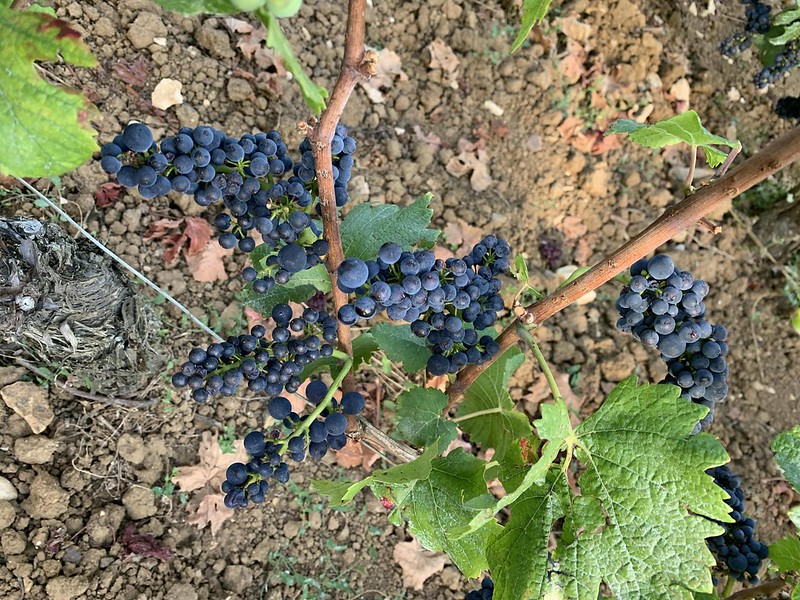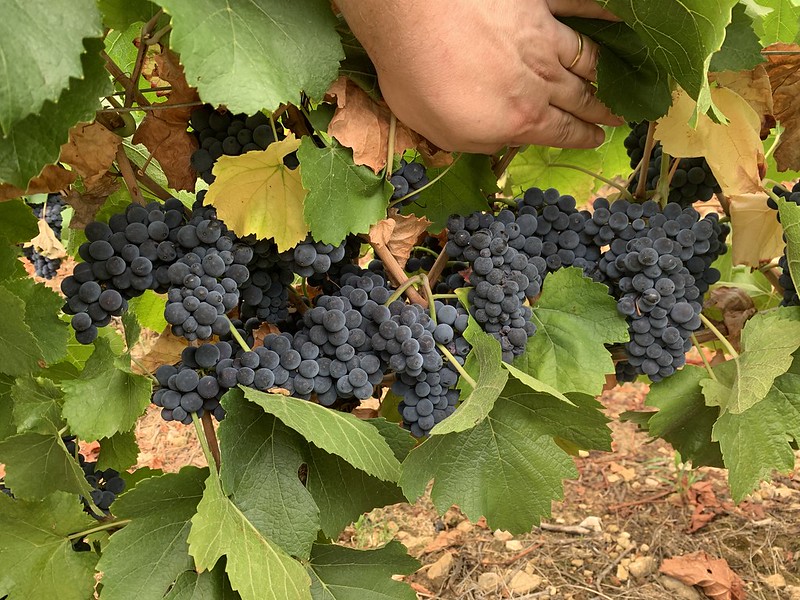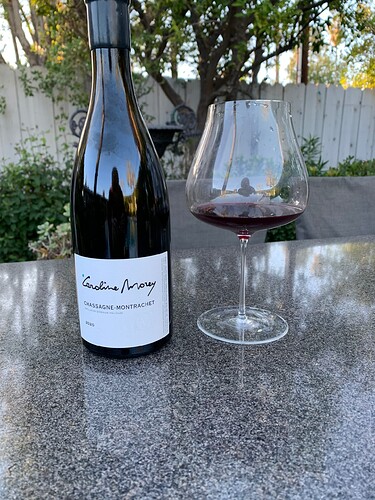Sipping on a 2020 Caroline Morey Chassagne Rouge while cooking dinner. Very nice wine! Apparently this wine has about 40% Pinot Fin. Other than Arnoux Lachaux who makes a Bourgogne Pinot Fin I have not seen many burgundies that show they have Pinot Fin in their wines. Are there many? And is there any distinctive flavor profile that one would notice? It seems that it might be a bit more coarse or rustic but there is not much information available.
Thanks for any information.
Julien Guillot of Clos des Vignes du Maynes makes a great Pinot Fin.
“Pinot fin” is just a catch-all term used to refer to lower yielding, higher-quality selections of Pinot Noir that produce small, open clusters that deliver high quality wines with concentrated flavors and refined tannins. Think of clusters like this:
 Dugat-Py Gevrey-Chambertin by WilliamGFKelley, on Flickr
Dugat-Py Gevrey-Chambertin by WilliamGFKelley, on Flickr
The other end of the extreme being highly productive, fat-berried selections/clones such as this:
 Chassagne Pinot Noir by WilliamGFKelley, on Flickr
Chassagne Pinot Noir by WilliamGFKelley, on Flickr
Many top domaines in the Côte d’Or are planted with selections that could be described as Pinot Fin, though historically, there has been more in the Côte de Nuits than the Côte de Beaune, and more in Volnay and Pommard than the rest of the Côte de Beaune. In the aftermath of phylloxera, high yielding selections were propagated in places such as Santenay, Pernand and Marsannay, whereas villages like Volnay tended to stick to higher quality selections. In general, it’s fair to say that Pinot fin is quite rare in Chassagne, where productive selections tended to be quite warmly embraced (hence cordon pruning for red in Chassagne, in an attempt to somewhat mitigate the vigor).
Thanks for the great explanation. Do many producers give information regarding the make up of their vineyards, like Dugat-Py shown above?
Mostly only in generalities. That picture from Dugat-Py is one I took myself.
I believe the more productive clone is called ‘Pinot Droit’.
Can anybody tell me if this is cut-and-dried, as in two completely distinct clones, or if there are variations within them, or any clones out there that share some characteristics of each.
Thanks in advance to anybody who can help.
Dan Kravitz
Pinot Droit isn’t a clone but a selection, i.e. a family of individuals sharing similar characteristics that have been replicated (without, historically, being cleaned up). The same is true with so-called Pinot Fin. That’s why I used to word “selections” not clones in my initial post.
Thank you for the clarification.
Dan Kravitz
As William Kelley said Pinot Fin is a catch all for a bunch of clones.
Pinot is an ancient variety and has many mutations - some are obvious such as colour mutations and given different names (Blanc/Gris/Teinturer) or external (Meunier), others noticed in the vineyard such as the early ripening Precoce.
Over the centuries Pinot has adapted to its surroundings and has mutated to cope with them. Those adaptions have been selected and cloned. Some reckon there are more than 1,000 different clones, and say there is no such thing as a ‘Pinot Noir’.
Many vineyards grow several different clones and blend them to get the desired wine.
New World wineries - especially US ones - seem more open about stating the clone/s they use. (But only when they are the ‘good’ clones)
I was lucky enough to go to a tasting at Willamette Valley Vineyards in 2012. They had 4 different clones planted one clone to a row and all 4 rows next to each other. They were all treated the same, picked on the same day and vinified separately exactly the same and then bottled.
This is my note. The tasting was hosted by winemaker Don Crank, and the four clones were
• Wadenswil
• Pommard
• 667 (Dijon Clone)
• 777 ( Dijon Clone)
Followed by a blend of all four. All were 2008 vintage and were made in neutral barrels.
- Wadenswil
Don said this was a clonal selection made by Muller (of Muller-Thurgau fame) in Switzerland. Don uses it to add complexity to a blend of clones.
I found it had a smokiness to it and it was my second favourite.
- Pommard
Don said that the Pommard clone accounts for two-thirds of all Pinot Noir planted in Oregon and is the one most likely to be found as a stand alone. The clone originated in the Chateau de Pommard vineyard in France.
This was fuller, richer, silkier with rounded tannins. It’s a big, almost chewy, wine and my favourite of the four.
- Dijon Clone 667
Dan said this was an early ripening clone with smaller berries and coarser tannins.
I found it lacking flavour, thin and with a sour finish, my least favourite of the four.
- Dijon Clone 777
Don had faint praise for this, saying it was ‘good for blending’.
I found it interesting with a sweetness but also sour cherry notes, my third favourite.
- South Block
This is a blend of all four of the above clones, which Don called a “commercial blend”.
Didn’t seem to me to be greater than the sum of its parts and not as enjoyable as the 100% Pommard clone.
There were distinct and very noticeable differences between the wines from the four clones.
A Google search for Pinot Noir Clones will find lots of info, and I recall the book North American Pinot Noir by John Winthrop Haeger as info on clones - but perhaps someone could confirm that…
A chart showing the traits of the 7 most popular clones is here - Seven of the Most Popular Pinot Noir Clones, Compared (Chart) | VinePair
and this article has detailed info Heritage Clones of Pinot Noir | The PinotFile: Volume 12, Issue 8
But it’s a rabbit warren that you can go mad in. Never again will you be able to drink a ‘Pinot Noir’ without questioning ‘but which clone’ !!
Yes, Haeger’s book has a chapter on clones and selections. He published a revised version called Pacific Pinot Noir four years later, haven’t looked at that book.
-Al
Opened a 2020 Domaine Jean Fournier Bourgogne Pinot Fin last night - just spectacular, creamy black fruits. Possibly the best Bourgogne Rouge that I have seen. Full stop.
